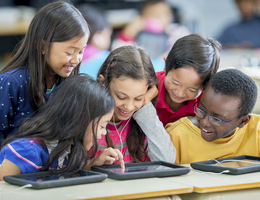
Lice can't hop, jump or fly. But they sure seem to get around.
Pediculosis, or a head lice infestation, often results from head-to-head contact with someone who has head lice or from sharing items such as combs, hats and towels, according to the National Pediculosis Association (NPA). Anyone can get head lice, but children in school or day care are especially susceptible.
Creepy crawlers
Head lice are clear or white when they first hatch but quickly become reddish-brown after feeding.
And what's for dinner? Human blood. Lice rely on blood from their human host to survive.
Head lice are about the size of sesame seeds. They can move quickly and will hide from light, making them a challenge to spot.
The female louse lays eggs, called nits. These small, yellowish-white, oval eggs are attached at an angle to the side of a strand of hair.
Once hatched, the lice live for about 30 days on their host.
Lice bites cause itching. If you notice your child or other family members scratching their heads frequently, you may want to check their scalps.
Itching for relief
Medical organizations differ in their recommendations for treating head lice. The NPA recommends special combs for removing lice and nits manually, while other groups recommend medicated shampoos.
To be safe, the American Academy of Family Physicians recommends checking with your doctor before you use lice-killing shampoo or lotion, as they contain pesticides and other chemicals. Using these products can be especially risky for pregnant and nursing women and for anyone with allergies, asthma, epilepsy or other medical conditions. These groups may be at risk even if they're using the product on someone else.
Pesticides should also never be used near the eyes to kill lice on eyebrows or eyelashes.
If you use these medicines to treat lice, be sure to follow the directions on the package carefully. Don't use a cream rinse or combination shampoo/conditioner before the lice medicine, as it could lessen the medicine's effectiveness. For the same reason, the Centers for Disease Control and Prevention recommends that you don't rewash the treated hair for one to two days.
After using the medicine, use a lice comb to remove any nits. Continue using the comb to check for and remove nits and lice every two to three days for two to three weeks.
Wash bedding, towels and clothing used by the person who had the lice. Use hot water and a hot clothes dryer. Vacuum furniture, carpets, car seats and stuffed animals. Soak hair combs and brushes in hot water for 5 to 10 minutes.
General rules
The NPA also offers these general tips on dealing with head lice:
- Watch for itching, often the first sign of head lice.
- Check all family members for lice and nits once a week.
- Always use lice-killing products over the sink, not in the tub or shower. This prevents other areas of your body from being exposed to pesticide. Keep the eyes covered.
- Avoid lice sprays.
- If your child has lice, notify the school, child care provider and neighborhood parents.
Reviewed 7/27/2023
Sources
- Centers for Disease Control and Prevention. "Head Lice: Treatment." https://www.cdc.gov/parasites/lice/head/treatment.html.
- Centers for Disease Control and Prevention. "Head Lice: Frequently Asked Questions (FAQs)." https://www.cdc.gov/parasites/lice/head/gen_info/faqs.html.
- FamilyDoctor.org. "Head Lice." https://familydoctor.org/condition/head-lice.
- HeadLice.org. "10 Steps to Staying Ahead of Lice." https://www.headlice.org/comb/what-are-head-lice-and-nits/frequently-asked-questions/10-steps-to-staying-ahead-of-lice.
- HeadLice.org. "Frequently Asked Questions." https://www.headlice.org/comb/what-are-head-lice-and-nits/frequently-asked-questions.
- HeadLice.org. “Lousology 101." https://www.headlice.org/comb/what-are-head-lice-and-nits/frequently-asked-questions/lousology-101.
- HeadLice.org. "What Are Head Lice and Nits?" https://www.headlice.org/comb/what-are-head-lice-and-nits.